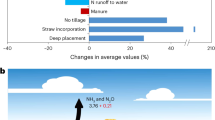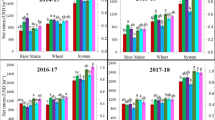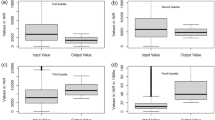Abstract
Sustainably feeding a growing population is a grand challenge1,2,3, and one that is particularly difficult in regions that are dominated by smallholder farming. Despite local successes4,5,6,7,8, mobilizing vast smallholder communities with science- and evidence-based management practices to simultaneously address production and pollution problems has been infeasible. Here we report the outcome of concerted efforts in engaging millions of Chinese smallholder farmers to adopt enhanced management practices for greater yield and environmental performance. First, we conducted field trials across China’s major agroecological zones to develop locally applicable recommendations using a comprehensive decision-support program. Engaging farmers to adopt those recommendations involved the collaboration of a core network of 1,152 researchers with numerous extension agents and agribusiness personnel. From 2005 to 2015, about 20.9 million farmers in 452 counties adopted enhanced management practices in fields with a total of 37.7 million cumulative hectares over the years. Average yields (maize, rice and wheat) increased by 10.8–11.5%, generating a net grain output of 33 million tonnes (Mt). At the same time, application of nitrogen decreased by 14.7–18.1%, saving 1.2 Mt of nitrogen fertilizers. The increased grain output and decreased nitrogen fertilizer use were equivalent to US$12.2 billion. Estimated reactive nitrogen losses averaged 4.5–4.7 kg nitrogen per Megagram (Mg) with the intervention compared to 6.0–6.4 kg nitrogen per Mg without. Greenhouse gas emissions were 328 kg, 812 kg and 434 kg CO2 equivalent per Mg of maize, rice and wheat produced, respectively, compared to 422 kg, 941 kg and 549 kg CO2 equivalent per Mg without the intervention. On the basis of a large-scale survey (8.6 million farmer participants) and scenario analyses, we further demonstrate the potential impacts of implementing the enhanced management practices on China’s food security and sustainability outlook.
This is a preview of subscription content, access via your institution
Access options
Access Nature and 54 other Nature Portfolio journals
Get Nature+, our best-value online-access subscription
$29.99 / 30 days
cancel any time
Subscribe to this journal
Receive 51 print issues and online access
$199.00 per year
only $3.90 per issue
Buy this article
- Purchase on Springer Link
- Instant access to full article PDF
Prices may be subject to local taxes which are calculated during checkout



Similar content being viewed by others
References
Foley, J. A. et al. Solutions for a cultivated planet. Nature 478, 337–342 (2011)
Matson, P. A., Parton, W. J., Power, A. G. & Swift, M. J. Agricultural intensification and ecosystem properties. Science 277, 504–509 (1997)
Tilman, D., Balzer, C., Hill, J. & Befort, B. L. Global food demand and the sustainable intensification of agriculture. Proc. Natl Acad. Sci. USA 108, 20260–20264 (2011)
Chen, X. P. et al. Integrated soil–crop system management for food security. Proc. Natl Acad. Sci. USA 108, 6399–6404 (2011)
Chen, X. et al. Producing more grain with lower environmental costs. Nature 514, 486–489 (2014)
Cui, Z. et al. Closing the yield gap could reduce projected greenhouse gas emissions: a case study of maize production in China. Glob. Change Biol. 19, 2467–2477 (2013)
Ladha, J. K. et al. Agronomic improvements can make future cereal systems in South Asia far more productive and result in a lower environmental footprint. Glob. Change Biol. 22, 1054–1074 (2016)
Liu, Y. et al. Net global warming potential and greenhouse gas intensity from the double rice system with integrated soil–crop system management: a three-year field study. Atmos. Environ. 116, 92–101 (2015)
Alexandratos, N. How to feed the world in 2050. In The Proceedings of a Technical Meeting of Experts 1–32 (FAO, 2009)
Garnett, T. et al. Sustainable intensification in agriculture: premises and policies. Science 341, 33–34 (2013)
Gunton, R. M., Firbank, L. G., Inman, A. & Winter, D. M. How scalable is sustainable intensification? Nat. Plants 2, 16065 (2016)
Sanchez, P. A. En route to plentiful food production in Africa. Nat. Plants 1, 14014 (2015)
Dixon, J ., Gulliver, A. & Gibbon, D. Farming Systems and Poverty (FAO, 2001)
Pretty, J. Agricultural sustainability: concepts, principles and evidence. Phil. Trans. R. Soc. B 363, 447–465 (2008)
Denning, G. et al. Input subsidies to improve smallholder maize productivity in Malawi: toward an african green revolution. PLoS Biol. 7, e1000023 (2009)
IFA. IFADATA http://ifadata.fertilizer.org/ucSearch.aspx (International Fertilizer Industry Association, 2011)
Zhang, X. et al. Managing nitrogen for sustainable development. Nature 528, 51–59 (2015).
Guo, J. H. et al. Significant acidification in major Chinese croplands. Science 327, 1008–1010 (2010)
Diaz, R. J. & Rosenberg, R. Spreading dead zones and consequences for marine ecosystems. Science 321, 926–929 (2008)
Zhang, W. et al. Closing yield gaps in China by empowering smallholder farmers. Nature 537, 671–674 (2016)
Searchinger, T. et al. The great balancing act. Installment 1 of creating a sustainable food future. World Resources Institutehttp://www.worldresourcesreport.org (2013)
Zhang, F., Chen, X. & Vitousek, P. Chinese agriculture: an experiment for the world. Nature 497, 33–35 (2013)
FAO. FAOSTAT. Statistics Division of the Food and Agriculture Organization of the United Nations http://www.fao.org/faostat/en/#home (FAO, 2016)
Spielman, D. J., Byerlee, D., Alemu, D. & Kelemework, D. Policies to promote cereal intensification in Ethiopia: the search for appropriate public and private roles. Food Policy 35, 185–194 (2010)
Matson, P ., Clark, W. C. & Andersson, K. Pursuing Sustainability: a Guide to the Science and Practice (Princeton Univ. Press, 2016)
Zhao, P. F. et al. Training and organization programs increases maize yield and nitrogen-use efficiency in smallholder agriculture in China. Agron. J. 108, 1944–1950 (2016)
National Bureau of Statistics of China. China Statistical Yearbook (China Statistics Press, 2016)
IFAD & UNEP. Smallholders, Food Security and the Environment (International Fund for Agricultural Development, 2013)
Li, Q., Huang, J. K., Luo, R. F. & Liu, C. F. China’s labor transition and the future of China’s rural wages and employment. China World Econ. 21, 4–24 (2013)
Braschkat, J., Mannheim, T., Horlacher, D. & Marschner, H. Measurement of ammonia emissions after liquid manure application: I. Construction of a wind tunnel system for measurements under field conditions. Z. Pflanz. Bodenkunde 156, 393–396 (1993)
Holland, E . et al. in Standard Soil Methods for Long-Term Ecological Research (eds Robertson, G. P . et al.), 185–201 (Oxford Univ. Press, 1999)
Lehmann, J. & Schroth, G. in Trees, Crops and Soil Fertility — Concepts and Research Methods (eds Schroth, G . & Sinclair, F. ) Ch. 7 151–165 (CAB International, 2003)
Zhao, R., Chen, X. & Zhang, F. Nitrogen cycling and balance in winter-wheat–summer-maize rotation system in Northern China. Acta Pedol. Sin. (In Chinese) 46, 684–697 (2009)
Audsley, E. et al. Harmonisation of environmental life cycle assessment for agriculture. Final Report. Concerted Action MR3-CT94-2028. Silsoe Research Institute, Silsoe, UK (1997)
IPCC. 2006 IPCC Guidelines for National Greenhouse Gas Inventories, Prepared by the National Greenhouse Gas Inventories (eds Eggelston, S . et al.) (Cambridge Univ. Press, 2006)
Smith, P . et al. in Climate Change 2007: Mitigation of Climate Change (eds Metz, B . et al.) (Cambridge Univ. Press, 2007)
SAS Institute. SAS User’s Guide: Statistics (SAS Institute, 1998)
Acknowledgements
We acknowledge all those who provided local assistance or technical help during the national campaign. We also thank J. D. Toth at the University of Pennsylvania for editing assistance. This work was financially supported by the Chinese National Basic Research Program (2015CB150400), the Innovative Group Grant from the NSFC (31421092), the Special Fund for Agro-scientific Research in the Public Interest (201103003), and National Natural Science Foundation—Outstanding Youth Foundation (31522050).
Author information
Authors and Affiliations
Contributions
F.Z., X.C. and Z.C. designed the research and F.Z. supervised the project. Z.C., H.Z., G.M., Y.M., X.L., W.M., Q.G., J.Y., Z.W., Y. Ye, S.G., J.L., J.H., S. Lv, Y.S., Y.L., X.P., J.R., S. Li, X.D., X.S., Qia.Z., Z.Y., L.T., C.W., L.J., J.Z., M.H., Y.T., Q.T., X.Z., Z.L., N.C., C.K. and M.F. were key players as regional coordinators or group leaders for the field trials and national campaign; W.M., C.H., C.Z., W.Z., H.Y., Y. Yin, R.J., X.J. and Qin.Z. collected and analysed the data. Z.C., F.Z. and Z.D. wrote the manuscript.
Corresponding author
Ethics declarations
Competing interests
The authors declare no competing financial interests.
Additional information
Reviewer Information Nature thanks N. Mueller, D. Powlson, J. Reganold and L. Samberg for their contribution to the peer review of this work.
Publisher's note: Springer Nature remains neutral with regard to jurisdictional claims in published maps and institutional affiliations.
Extended data figures and tables
Extended Data Figure 1 Distribution of field trials for maize, rice and wheat systems from 2005 to 2015 in China.
The four coloured regions represent different agroecological zones for maize, rice and wheat. Numbers in brackets are site years. Dots denote individual sites. The Chinese map was obtained from the Resource and Environment Data Cloud Platform (http://www.resdc.cn/data.aspx?DATAID=202).
Extended Data Figure 2 Exponential models describing the relationship between N2O emissions and nitrogen rate.
N2O–N emissions were plotted against nitrogen rate for maize (n = 417), rice (n = 740) and wheat (n = 395). Red dotted lines are IPCC model-based calculations35. NC, CC and SC refer to north China, central China and south China, respectively, for maize and wheat production; NC-R, YR-R and SC-R refer to north China, Yangtze River Basin and south China, respectively, for rice production. **P < 0.01 and *P < 0.05 indicate the significance of the regression.
Extended Data Figure 3 Exponential models describing the relationship between NO3− leaching and nitrogen rate.
The NO3− leaching was plotted against nitrogen rate for maize (n = 238), rice (n = 150) and wheat (n = 201). The red dotted line is the IPCC model-based calculation35. NC, CC and SC refer to north China, central China and south China, respectively, for maize and wheat production. **P < 0.01 indicates the significance of the regression.
Extended Data Figure 4 Exponential models describing the relationship between nitrogen runoff and nitrogen rate for rice (n = 216).
NC, YR and SC refer to north China, Yangtze River Basin and south China, respectively, for rice production.
Extended Data Figure 5 Linear models describing the relationship between NH3 volatilization and nitrogen rate.
NH3–N volatilization was plotted against nitrogen rate for maize (n = 315), rice (n = 423) and wheat (n = 279) growing seasons, respectively. The red dotted line is the IPCC model35. NC, CC and SC refer to north China, central China and south China, respectively, for maize and wheat production; NC, YR and SC refer to north China, Yangtze River Basin and south China, respectively, for rice production. **P < 0.01.
Supplementary information
Supplementary Information
This file contains an extended reference list, Supplementary Discussions and Supplementary References. (PDF 2604 kb)
Source data
Rights and permissions
About this article
Cite this article
Cui, Z., Zhang, H., Chen, X. et al. Pursuing sustainable productivity with millions of smallholder farmers. Nature 555, 363–366 (2018). https://doi.org/10.1038/nature25785
Received:
Accepted:
Published:
Issue Date:
DOI: https://doi.org/10.1038/nature25785
This article is cited by
-
Challenges of optimal crop management
Nature Food (2024)
-
Diversifying crop rotation increases food production, reduces net greenhouse gas emissions and improves soil health
Nature Communications (2024)
-
Managing fragmented croplands for environmental and economic benefits in China
Nature Food (2024)
-
Spatiotemporal co-optimization of agricultural management practices towards climate-smart crop production
Nature Food (2024)
-
In the shadow of state-led agrarian reforms: smallholder pervasiveness in rural China
Agriculture and Human Values (2024)
Comments
By submitting a comment you agree to abide by our Terms and Community Guidelines. If you find something abusive or that does not comply with our terms or guidelines please flag it as inappropriate.



